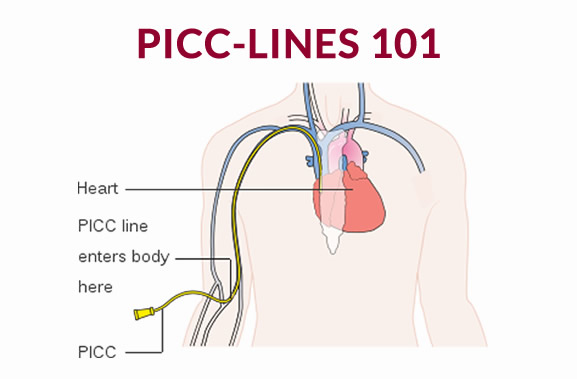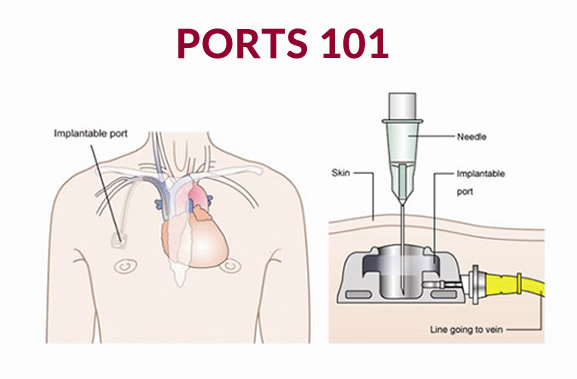What To Know About PICC Lines and Ports | Cancer 101
Chemotherapy drugs can be given in a variety of different ways. They can be taken in pill or capsule form, into a vein, injected into a body cavity, into a muscle or into the spinal fluid. Unfortunately, some of these are known to cause discomfort or pain to the patient, so in some cases it may be favorable to administer IV chemotherapy through a central venous catheter (CVC), such as a peripherally inserted central catheters (PICC line) and portacaths (ports).

What is a PICC Line?
A PICC line is a thin, soft, long catheter (tube) that is inserted into a vein in your upper arm. The tip of the catheter is positioned in a large vein that transfers blood into the heart. The PICC line is placed to provide repeated access to your veins for a variety of circumstances such as long term medication treatment, like chemotherapy, blood draws and for nutrition.
PICC Line Insertion:
The insertion of the PICC line does not require surgery. A specialist nurse or doctor places a PICC line into a large vein in your arm and guides the CVC up into the main vein near your heart where blood flows quickly. Once the PICC is in place, the catheter tube will stick out of your skin. You will have an x-ray to check it’s in the correct position. It takes about 1 - 1 ½ hours to place the PICC line. The PICC line is held in place by a dressing, and the first dressing change will be 24 to 72 hours after insertion. It should later be changed once a week or when it is loose, wet or unclean.
When you no longer need the PICC line, it will be taken out, although some people choose to keep it for longer than others. PICC line removal is typically a painless procedure and only takes a few minutes to complete by a trained nurse. PICC line removal aftercare is very important to follow in order to prevent possible infection.
Risks of a PICC Line:
As with any procedure there are certain risks, but they are minimal:
- You may get an infection at the insertion site or in your bloodstream.
- The catheter may need to be taken out and you may need antibiotics.
- A piece of catheter may break off and move into the bloodstream.
- The catheter can move out of place in the vein if you cough or move a lot or have acute vomiting.
- Some patients experience blood clots
To avoid these risks, there are some activities one should limit or restrict, such as:
- Constant arm movement
- Moving heavy objects
- Weight lifting
- Swimming
- Hot tubs
Risks should be minimal if instructions are followed.
Benefits of a PICC Line:
With a PICC line, there is a smaller chance of irritation and damage to your veins and blood vessels from many blood draws, IV insertions, and IV medicines. PICCs avoid the pain and injury involved in repeated punctures. The goal is to spare your veins from the constant needle injections. A PICC line can be cared for at home and can stay in place for many weeks, or months, if needed.
PICC Line Alternatives:
If a PICC line isn't for you, there are some alternatives. The most common alternative is a portacath, also known as a port. See below for more information about a port.
Remember, everyone is different, so please ask your doctor if a PICC line is right for you.
Sources:
Macmillion Cancer Support
Cpmc.org
My Cleveland Clinic
MercyAngiography.co.nz
LiveBetterWith.com
CancerConnect.com

What is a Port?
A portacath, more commonly known as a port, is a device composed of two parts, a small reservoir (port) and a catheter, a thin flexible tube. It is used to draw blood and give treatments, including intravenous fluids, medication, or blood transfusions. The port is generally implanted under the skin in the upper right side of the chest, and it is attached to the catherer that is threaded into the large jugular vein above the right side of the heart. This vein is preferred because it is close to the skin and simple to find with ultrasound. It also has the lowest risk for problems during placement of the catheter. The port has a silicone septum that can be punctured with a needle, and because of its resistant and self-sealing material, it can be pierced hundreds of times before the port needs replacement.
Port Insertion:
The procedure for insertion of a portacath is safe and quick, taking only from 30 minutes to an hour, and is performed under local anesthesia by an interventional radiologist or surgeon. It is typically safe to go home a few hours after the procedure, and it can be ready for use in one week. Patients might experience some discomfort at the incision after the insertion, but it should only last for 2-3 days and can be easily managed with oral pain medication.
Risks of a Port:
As with any catheter, there are some risks involved with having a portacath, but fortunately they are minimal. These include:
- Occlusion or blockage of line
- Dislodgement of port or line
- Damage to the port
- Wound infection
Benefits of a Port:
- Avoid puncture wounds and damage directly to the vein, making treatment less painful.
- A problem sometimes associated with direct needle insertion to the vain is extraversion, which is when chemotherapy leaks from the infusion site, causing damage to the skin and surrounding tissue. With a portacath, this is unlikely to occur.
- Since the portacath is easily visible (about the size of a quarter) and felt, it makes for more efficient access.
- Durable for years, taking about 2,000 punctures on average.
Port Alternatives:
If a port isn't for you, there are other options, such as a PICC Line. See above to learn more about a PICC Line.
Sources:
Sir.net.au
Cancer.gov
MissionHopeCancercenter.com
MercyAngiography.co.nz
Did you have chemo through a PICC Line, port, or another way? Share in the comments below!








Team I Had Cancer is the group of people behind the scenes, making sure IHadCancer.com is running, and that you're connecting to the people you need to know for the support and information you need while dealing with cancer.